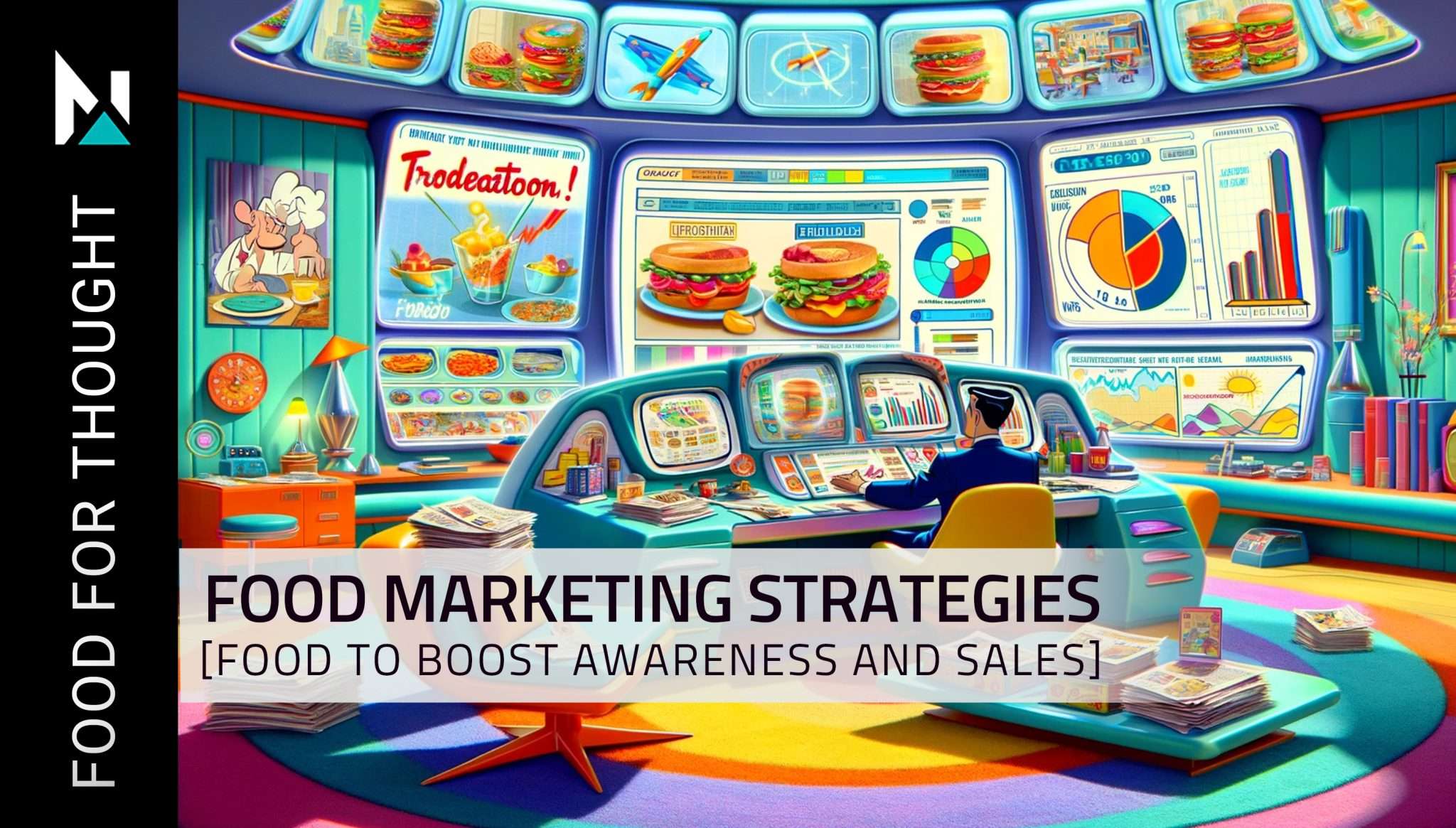Mar 20, 2024
Food Marketing Strategies to Boost Awareness and Sales
Food Marketing Strategies to Boost Your Brand Awareness and Sales

Time-tested food marketing strategies are crucial for brands to stand out and connect with consumers. It is also crucial to drive sales in a competitive marketplace. Effective marketing ensures your food brand is visible, memorable, and resonates with your target audience’s preferences and values. Through strategic campaigns, you can communicate your brand’s unique selling points, fostering trust and loyalty among consumers. Consistent marketing efforts can help maintain brand relevance and adapt to changing market dynamics.
Proven Strategies
NewPoint utilizes proven strategies to enhance brand recognition, engage customers, and maximize sales potential. There are diverse avenues to elevate your brand’s presence and impact in the food industry. From leveraging social media platforms to crafting compelling storytelling in advertising. By implementing these strategies, you can establish a stronger foothold in the market and drive sustainable growth for your food brand.
Understanding Your Audience
Understanding Your Audience is the cornerstone of successful food marketing and branding. It involves a multi-faceted approach that begins with identifying your target demographics. This means looking closely at factors such as age, gender, location, income level, and lifestyle preferences. By understanding who your audience is, we can tailor your marketing efforts to speak directly to their needs and desires.
Analyzing consumer behaviors and preferences
Analyzing consumer behaviors goes hand in hand with understanding your audience. This step involves delving deep into the psychology behind why people make the food choices they do. We look at their habits, preferences, and motivations, whether they’re driven by health concerns, convenience, ethical considerations, or other factors. By understanding what drives your audience’s purchasing decisions, we can create marketing campaigns that resonate with them on a personal level.
Market research to tailor food marketing efforts
Utilizing market research is essential for staying ahead of the curve in the ever-changing landscape of the food industry. Through surveys, focus groups, and data analysis, we gain valuable insights into current trends, emerging preferences, and shifting consumer behaviors. This data allows us to adapt our food markeitng strategies accordingly. This ensures that your brand remains relevant and competitive in the market. By staying informed and responsive to the needs of your target audience, we can position your brand for long-term success and growth.
Food Marketing Strategies: Branding and Positioning
More than just creating a logo or choosing a catchy slogan, branding and positioning are vital steps in making your food marketing memorable and successful in a crowded market. They’re about shaping how your food business is perceived, establishing a connection with your audience, and carving out a distinct space in the market. By carefully defining your brand identity, establishing a unique selling proposition, crafting a compelling brand story, and positioning your brand effectively, you can set your business up for success in the competitive world of food marketing.
Defining your brand identity
This is akin to giving your business its own personality. It involves understanding what your business stands for, what values it embodies, and how you want it to be perceived by your customers. Think of it as the soul of your brand, encompassing everything from your logo and color scheme to your company’s mission and vision.
Establishing a unique selling proposition (USP)
Your USP is what sets your food business apart from competitors. It’s the unique benefit or advantage that only you can offer to your customers. Whether it’s your secret recipe, or unparalleled customer service, your USP is what will attract and retain customers in a competitive market.
Crafting a compelling brand story
Stories have the power to captivate and engage, and your brand story is no exception. It’s not just about what you sell but why you sell it. Your brand story should resonate with your target audience, evoking emotions and forging connections. A compelling brand story can turn casual customers into loyal advocates. Whether it’s the journey of your founders, or the impact your business aims to make in the world.
Positioning your brand effectively in the market
it’s time to position your brand strategically in the market once you’ve defined your brand identity, USP, and crafted a compelling brand story. This involves understanding your target audience, identifying key competitors, and finding a unique space for your brand to occupy in the minds of consumers. Effective positioning can help you stand out and attract your ideal customers. Whether you’re positioning your brand as a premium luxury option, a budget-friendly choice, or a niche product catering to specific dietary preferences.
Digital Marketing Strategies—Start with a Killer Website
In the realm of food marketing, your website serves as more than just an online presence; it’s your brand’s virtual storefront, a digital hub where visitors can explore your products, learn about your story, and connect with your values. A well-designed and engaging website not only captivates visitors but also cultivates trust and loyalty, ultimately driving conversions and sales.
Leveraging social media platforms
Social media platforms have revolutionized the way brands interact with their audience. With billions of users worldwide, platforms like Instagram, Facebook, and Twitter offer an unparalleled opportunity to engage with consumers, share captivating content, and build meaningful relationships. Leveraging these platforms effectively involves crafting compelling posts, fostering community engagement, and staying authentic to your brand’s voice and identity.
Implementing email marketing campaigns
Email marketing remains a cornerstone of digital communication strategies, offering a direct line of communication with your audience. By curating targeted and personalized campaigns, you can deliver relevant content, exclusive offers, and valuable insights straight to your subscribers’ inboxes. From newsletters to promotional emails, email marketing allows you to nurture leads, drive conversions, and foster long-term customer relationships.
Exploring influencer partnerships
Influencer partnerships have emerged as a powerful avenue for brands to expand their reach and credibility in the digital sphere. Collaborating with influencers who align with your brand values and resonate with your target audience can significantly amplify your message. Whether through sponsored content, product reviews, or brand ambassadorships, influencers have the ability to authentically promote your products, driving awareness, engagement, and ultimately, conversions.
Food Marketing 104: Packaging Design and Visual Identity
Importance of packaging
Packaging Design and Visual Identity are pivotal components in the realm of food marketing. Firstly, it’s essential to recognize the paramount importance of packaging in the overall marketing strategy. Beyond merely containing the product, packaging serves as the first point of contact between the brand and the consumer. It not only conveys vital information about the product but also communicates the brand’s values, personality, and story. In a highly competitive market, where countless options vie for consumers’ attention, packaging plays a critical role in attracting and engaging potential buyers. Therefore, investing in well-designed packaging is akin to investing in the brand’s success and market positioning.
Designing eye-catching packaging
When it comes to designing eye-catching packaging, several factors come into play. It’s not merely about creating something visually appealing but also ensuring that it effectively communicates the brand message and stands out amidst a sea of competing products. Eye-catching packaging should captivate consumers’ attention instantly, drawing them in for a closer look. This can be achieved through a combination of vibrant colors, compelling imagery, and unique design elements that resonate with the target audience. Furthermore, it’s essential to consider practical aspects such as packaging functionality and shelf impact. A well-designed package not only looks good but also enhances the overall consumer experience, making it easier for them to identify, purchase, and use the product.
Consistency in visual branding across all channels
Consistency in visual branding is another critical aspect that cannot be overlooked. In today’s interconnected world, consumers interact with brands across multiple touchpoints, both online and offline. Therefore, it’s imperative to maintain a cohesive visual identity across all channels to ensure brand recognition and foster consumer trust. Consistency in visual branding entails using the same logo, colors, fonts, and design elements across various marketing materials, including packaging, websites, social media, and advertising campaigns. This uniformity creates a sense of familiarity and reinforces the brand’s identity in the minds of consumers. Additionally, consistent branding helps to establish brand credibility and reliability, as consumers associate the brand with quality and professionalism. Overall, maintaining visual consistency is key to building a strong and memorable brand presence in the competitive food marketing landscape.
Promotions and Campaigns
Planning promotional events is akin to orchestrating a symphony of elements that harmonize to elevate brand presence. From choosing the perfect venue that reflects the brand’s essence to curating engaging experiences that resonate with attendees, every detail is meticulously crafted. We delve deep into understanding the brand’s identity and objectives, ensuring that the event seamlessly aligns with its overarching marketing strategy. Whether it’s a product launch, a tasting event, or a community outreach initiative, our goal is to create memorable experiences that leave a lasting impression on attendees and reinforce brand recognition.
Implementing sales promotions and discounts
Sales promotions and discounts requires a delicate balance between driving sales and preserving the brand’s perceived value. Through comprehensive market analysis and consumer insights, we identify opportune moments and channels to roll out promotions effectively. From limited-time offers to bundle deals, our strategies are tailored to resonate with target audiences and incentivize purchase behavior. By leveraging data-driven approaches, we optimize promotional efforts to not only boost short-term sales but also foster long-term customer loyalty and brand affinity.
Creating memorable advertising campaign
A memorable advertising campaigns can be an art form that blends creativity with strategic intent. It begins with a deep dive into understanding the brand’s unique selling propositions and target audience personas. Armed with insights, we craft compelling narratives and visually captivating content that captivates and resonates with viewers. Whether it’s a television commercial, social media campaign, or outdoor advertising, our focus is on evoking emotional connections and sparking conversations. Through meticulous planning and execution, we strive to create campaigns that transcend mere advertising and become cultural touchpoints, embedding the brand into the fabric of consumers’ lives.
Measuring Success and Adjusting Strategies
Setting clear marketing goals and Key Performance Indicators (KPIs) is akin to charting a course for success in the vast sea of marketing endeavors. Without a clear destination in mind, a marketing campaign may drift aimlessly, missing opportunities and failing to make a meaningful impact. Therefore, it’s imperative to establish specific, measurable, achievable, relevant, and time-bound (SMART) objectives. These goals could encompass a wide range of outcomes, from increasing brand visibility and driving website traffic to boosting sales and improving customer retention rates. Each goal should be accompanied by corresponding KPIs, serving as navigational markers along the journey. These KPIs act as performance benchmarks, allowing us to track progress and evaluate the effectiveness of our marketing efforts. By setting clear goals and KPIs, we provide a clear direction for our marketing initiatives, guiding our actions and investments towards tangible results.
Performance metrics
Analyzing performance metrics is akin to taking stock of our progress on the marketing voyage. To ensure we stay on course, marketers must regularly assess performance metrics to gauge the effectiveness of their strategies. This involves collecting and interpreting data from various sources, such as website analytics, social media insights, email marketing platforms, and sales reports. By delving into these metrics, we gain valuable insights into consumer behavior, campaign performance, and market trends. For instance, we may uncover which marketing channels are driving the most traffic or identify which content resonates most with our target audience. Armed with this knowledge, we can make informed decisions about where to allocate resources, which tactics to optimize, and where adjustments are needed to stay on track towards our marketing goals. Through continuous analysis of performance metrics, we remain agile and responsive, adapting our strategies to navigate changing currents and seize emerging opportunities.
Data-driven decisions to optimize marketing efforts
Making data-driven decisions to optimize marketing efforts is the cornerstone of effective marketing strategy in the digital age. Today’s marketers have access to a wealth of data that can inform and enrich their decision-making process. By leveraging analytics tools we can uncover hidden patterns, trends, and correlations within vast datasets. This can help transforming raw numbers into actionable insights. These insights empower us to make informed choices about which marketing tactics to pursue. Including which audience segments to target, and which messages to communicate. Analysis may reveal that a particular advertising campaign is underperforming in terms of ROI. We can swiftly reallocate budget to more fruitful channels or adjust messaging to better resonate with the target audience.
Food Marketing Strategies: Insight, Creativity, and Adaptability
In the ever-evolving landscape of food marketing, success hinges on a combination of strategic insight, creativity, and adaptability. At NewPoint Marketing, we’re dedicated to helping food brands navigate this dynamic terrain with confidence and purpose. From crafting compelling brand stories to implementing data-driven digital marketing strategies, we offer a comprehensive suite of services designed to elevate your brand’s presence and drive meaningful engagement with your target audience. With a keen understanding of consumer behaviors, market trends, and the unique challenges facing the food industry, we’re committed to delivering results that exceed expectations.
Whether you’re looking to boost brand awareness, increase sales, or forge deeper connections with your customers, contact NewPoint Marketing. Together, we’ll unlock the full potential of your food brand and create lasting impressions in the hearts and minds of consumers.





